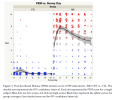There are a lot of things get repeated so many times that everyone believes them, but may not actually be true. I'd like to know what's actually true about PEM.
Regarding whether we actually have evidence to suggest that
delayed onset is the key feature of PEM in ME/CFS, I read this sentence in
Wormgoor & Rodenburg 2023, discussed
here:
The delayed onset and the broad constellation of symptom deteriorations
distinguish ME/CFS from other diseases with severe fatigue or deconditioning (
6,
16–
21).
I've been looking at the references given for this. So far I don't see anything in 6, 16, 17, 18 that supports this claim.
Note I have to skim rather than read in full, so I may have missed some details. Please tell me if I have and I will amend this post.
Reference 19 is
Hodges et al. 2017, a 2-day CPET study. This is at least a study including both ME and MS participants, and did find that MS patients had a higher workload at RER on day 2 CPET, whereas CFS patients had a lower workload on day 2 CPET. Symptoms were not assessed, though, so we don't know whether patients would have reported PEM at the time, or been aware that their functioning was a bit lower. We also don't know when any symptoms started - during CPET 1? Immediately after? A few hours after? A day after? I don't think reference 19 supports the claim either.
20 is
Klebek et al. 2020 (Jason's group), a questionnaire-based study. People with "ME and CFS" did report more DSQ-defined PEM, but people with post-polio syndrome reported plenty of it too. Timing of onset of PEM was not explored. If anything, this just demonstrates that either people's concerns about the Jason team's definition of PEM are justified, or people's belief that PEM is unique to ME/CFS or uncommon in other diseases is not justified. So I don't think reference 20 supports Wormgoor et al's claim.

Reference 21 is
van Campen et al. 2021, a 2-day CPET study comparing males with ME/CFS with males with idiopathic chronic fatigue. As in the study by Hodges above, those with idiopathic chronic fatigue improved their CPET performance on day 2, whereas those with ME/CFS did the opposite. But again, symptoms weren't assessed, and nor was timing of onset of symptoms. We don't know if patients were reporting PEM from CPET 1. All we know is that their functioning on a maximal exercise test was lower than the day before.
These references do not provide any support for the idea that delayed onset of post-exertional symptoms distinguishes ME/CFS from other diseases. The 2-day CPET studies comparing ME/CFS with other diseases demonstrate that people with ME/CFS function worse on a maximal exercise test on day 2 while people with other diseases and healthy people function better. That is a
very interesting finding, but it does not tell us anything about whether onset of PEM is immediate or delayed.
I think we can collect better data that will allow us to make accurate claims about PEM. If delayed onset really does distinguish ME/CFS from other diseases, then great. But if what's actually happening is that people with other fatiguing illness and ME/CFS both have increased symptoms and reduced functioning for 1-12 hours post-exertion, but people with other diseases recover thereafter while ME/CFS don't, or get worse symptoms, then it's a duration issue. And if people with ME/CFS don't reliably report increased symptoms even though we can see their functioning is deteriorating, we need to find a way to detect that without subjecting them to maximal exercise tests.
So I think we need exploratory studies.


